一、SpringSeurity的基础操作
1、引入主要依赖
<dependency>
<groupId>org.springframework.boot</groupId>
<artifactId>spring-boot-starter-security</artifactId>
</dependency>
此时我们在启动项目时会发现对于的页面都需要登录才能访问!默认用户名、密码是user,密码是控制台启动时打印的密码。

2、加密器
官方推荐使用BCryptPasswordEncoder这是一个基于Hash单向加密的加密类
@Test
public void contextLoads(){
BCryptPasswordEncoder bCryptPasswordEncoder = new BCryptPasswordEncoder();
//密码加密
String encode = bCryptPasswordEncoder.encode("123");
System.out.println(encode);
System.out.println("==========================");
//密码匹配,匹配成功返回true,否则返回false
boolean matches = bCryptPasswordEncoder.matches("123", encode);
System.out.println(matches);
}
打印结果:

在项目使用时一般将其放到Spring容器中
@Configuration
public class SecurityConfig {
@Bean
public PasswordEncoder getPw(){
return new BCryptPasswordEncoder();
}
}
3、实现自定义登录逻辑
实现SpringSecurity里的UserDetailsService接口的LoadUserByUsername方法便可以实现自定义登录逻辑。以下代码将实现用户名为admin,密码为123的登录。一旦使用了自定义登录逻辑,原本的user和打印的password登录将不再生效。此时,通过admin 123便可登录。
对于登出SpringSecurity也提供了一个/logout的接口。
SpringSecurity框架以为我们提供了一个需要username和passsword参数的登录接口/login 的post请求,需要登录时框架调用的便是该接口。
@Service
public class UserDetailsServiceImpl implements UserDetailsService {
@Autowired
private PasswordEncoder passwordEncoder;
@Override
public UserDetails loadUserByUsername(String username) throws UsernameNotFoundException {
//查询数据库判断用户名是否操作,如果不存在就会抛出UsernameNotFoundException异常
if (!"admin".equals(username)) {
throw new UsernameNotFoundException("用户名不存在!");
}
//2、把查询出来的密码(注册时已经加密过)进行解析,或者直接把密码放入构造方法
String password = passwordEncoder.encode("123");
return new User(username, password, AuthorityUtils.commaSeparatedStringToAuthorityList("admin,normal,ROLE_abc"));
}
}
4、访问限制
@Configuration
public class SecurityConfig extends WebSecurityConfigurerAdapter {
@Bean
public PasswordEncoder getPw() {
return new BCryptPasswordEncoder();
}
@Override
protected void configure(HttpSecurity http) throws Exception {
//授权认证
http.authorizeRequests()
//error.html不需要被认证
.antMatchers("/error.html").permitAll()
//login.html不需要被认证
.antMatchers("/login.html").permitAll()
//指定角色访问
.antMatchers("/main.html").hasRole("abc")
//指定权限访问
.antMatchers("/main.html").hasAuthority("admin")
//多个权限都可访问
.antMatchers("/main.html").hasAnyAuthority("admin,normal")
//多个角色都可以访问
.antMatchers("/main.html").hasAnyRole("ABC,abc")
//通过指定ip地址进行访问,注意这里的ip与localhost转换的ip是不一样的,线上一般为服务器ip
.antMatchers("/main.html").hasIpAddress("127.0.0.1")
//所有请求都必须被认证,必须登录之后被访问
.anyRequest().authenticated();
//关闭csrf防护
http.csrf().disable();
}
}
在访问限制配置时,我们只需要集成WebSecurityConfigurerAdapter配置类configure(HttpSecurity http)方法即可。

多个角色也类似:注意角色这里不要加前缀ROLE_

对应之前服务实现类的权限和角色:
5、自定义异常处理
首先添加异常处理类实现AccessDeniedHandler接口的handle方法,handle方法里可自定义处理SpringSecurity的403等异常的处理。
@Component
public class MyAccessDeniedHandler implements AccessDeniedHandler {
@Override
public void handle(HttpServletRequest httpServletRequest, HttpServletResponse httpServletResponse, AccessDeniedException e) throws IOException, ServletException {
//设置响应状态码
httpServletResponse.setStatus(HttpServletResponse.SC_FORBIDDEN);
httpServletResponse.setHeader("Content-Type", "application/json;charset=utf-8");
PrintWriter writer = httpServletResponse.getWriter();
writer.write("{\"status\":\"error\",\"msg\":\"权限不足,请联系管理员\"}");
writer.flush();
writer.close();
}
}
之后在SpringSecurity配置类里添加如下:
@Configuration
public class SecurityConfig extends WebSecurityConfigurerAdapter {
//注入异常处理类
@Autowired
private MyAccessDeniedHandler myAccessDeniedHandler;
......
@Override
protected void configure(HttpSecurity http) throws Exception {
......
//异常处理的配置
http.exceptionHandling()
.accessDeniedHandler(myAccessDeniedHandler);
}
}
当权限不足报403时,这里会调用我们自定义的方法:

6、通过注解的方式配置访问控制
** 角色控制访问:注意这里的ROLE_前缀不能去**
其他类开启注解@EnableGlobalMethodSecurity(securedEnabled = true)

控制类里添加@Secured(角色名)注解进行角色访问控制

当用户有ROLE_abC角色时会被允许访问,否则会报500错误!
使用@PreAuthorize注解来进行访问控制
类似的,启动类里的参数不同而已:

进行角色访问控制:@PreAuthorize("hasRole('abc')") //此时,有无ROLE_前缀都是可以被访问到的。要注意的时配置类里的hasRole方法是不允许以ROLE_前缀开头的这里有些差别。
同时也可用于权限控制访问:@PreAuthorize("hasAuthority('admin')")
二、Auth2认证方案
1、什么是Auth2认证

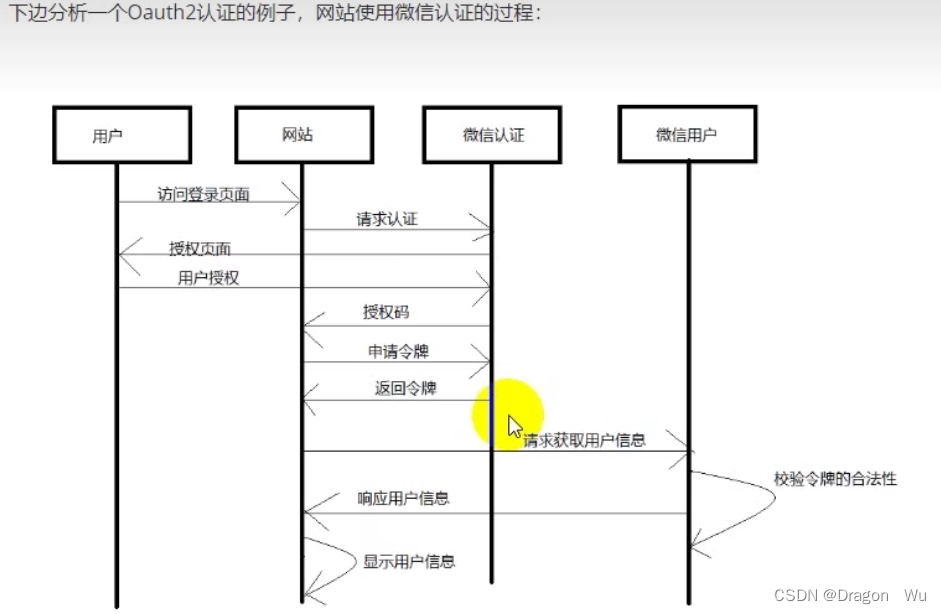
2、Oauth2最常用的授权模式
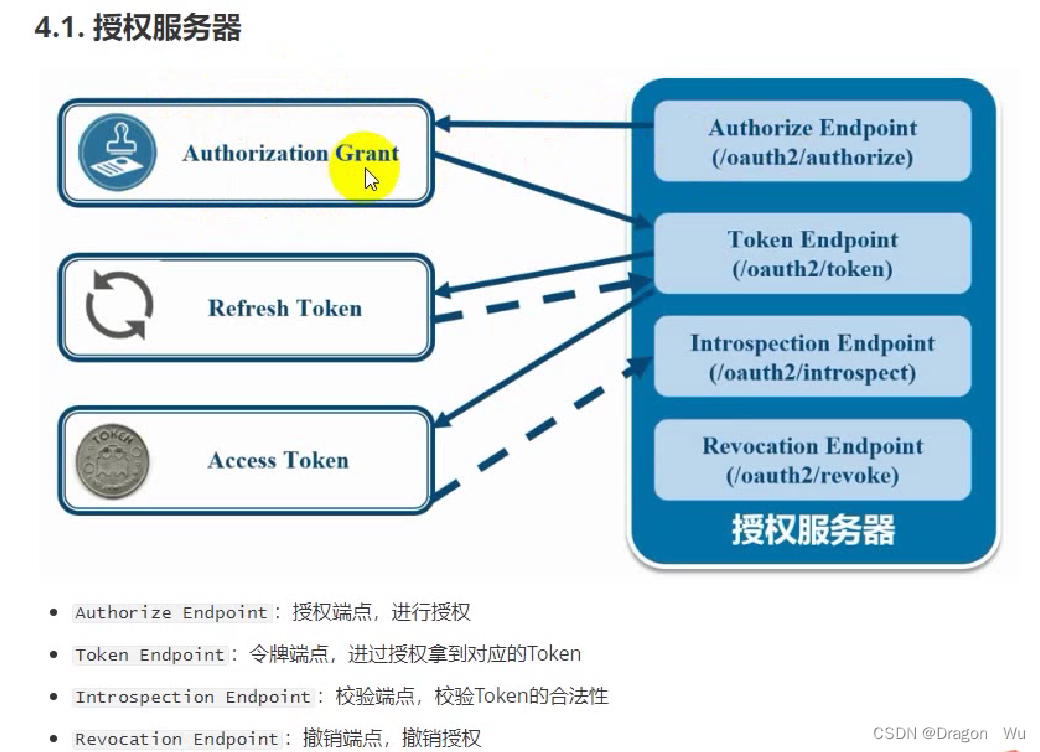
3、依赖引入
使用Oauth2时我们在SpringSecurity的依赖上添加如下依赖:
<dependency>
<groupId>org.springframework.cloud</groupId>
<artifactId>spring-cloud-starter-oauth2</artifactId>
</dependency>
4、添加配置类
(1)授权模式的配置类如下
SpringSecuirty的配置类:
@Configuration
@EnableWebSecurity
public class SecurityConfig extends WebSecurityConfigurerAdapter {
@Bean
public PasswordEncoder getPw() {
return new BCryptPasswordEncoder();
}
@Override
protected void configure(HttpSecurity http) throws Exception {
http.csrf().disable()
.authorizeRequests()
.antMatchers("/oauth/**","/login/**","/logout/**").permitAll()
.anyRequest().authenticated()
.and()
.formLogin().permitAll();
}
}
Oauth2的授权服务器配置:
@Configuration
@EnableAuthorizationServer //开启授权服务器
public class AuthorizationServerConfig extends AuthorizationServerConfigurerAdapter {
@Autowired
private PasswordEncoder passwordEncoder;
@Override
public void configure(ClientDetailsServiceConfigurer clients) throws Exception {
clients.inMemory()
//配置client-id
.withClient("admin")
//配置client-secret
.secret(passwordEncoder.encode("112233"))
//配置访问token的有效期
// .accessTokenValiditySeconds(3600)
//配置redirect_uri,用于授权成功后跳转
.redirectUris("http://www.baidu.com")
//配置申请的权限范围
.scopes("all")
//配置grant_type,表示授权类型
.authorizedGrantTypes("authorization_code");
}
}
Oauth2的资源服务器的配置类:
@Configuration
@EnableResourceServer //开启资源服务器
public class ResourceServerConfig extends ResourceServerConfigurerAdapter {
@Override
public void configure(HttpSecurity http) throws Exception {
http.authorizeRequests()
.anyRequest()
.authenticated()
.and()
.requestMatchers()
.antMatchers("/user/**");
}
}
密码模式的配置类如下:
SpringSecurity配置类:
@Configuration
@EnableWebSecurity
public class SecurityConfig extends WebSecurityConfigurerAdapter {
@Bean
public PasswordEncoder getPw() {
return new BCryptPasswordEncoder();
}
//用于密码认证
@Override
@Bean
public AuthenticationManager authenticationManagerBean() throws Exception{
return super.authenticationManagerBean();
}
@Override
protected void configure(HttpSecurity http) throws Exception {
http.csrf().disable()
.authorizeRequests()
.antMatchers("/oauth/**","/login/**","/logout/**").permitAll()
.anyRequest().authenticated()
.and()
.formLogin().permitAll();
}
}
授权服务器配置:
@Configuration
@EnableAuthorizationServer //开启授权服务器
public class AuthorizationServerConfig extends AuthorizationServerConfigurerAdapter {
@Autowired
private PasswordEncoder passwordEncoder;
@Autowired
private AuthenticationManager authenticationManager;
@Autowired
private UserDetailsServiceImpl userDetailsService;
//使用密码模式配置所需配置
@Override
public void configure(AuthorizationServerEndpointsConfigurer endpoints) throws Exception {
endpoints.authenticationManager(authenticationManager)
.userDetailsService(userDetailsService);
}
@Override
public void configure(ClientDetailsServiceConfigurer clients) throws Exception {
clients.inMemory()
//配置client-id
.withClient("admin")
//配置client-secret
.secret(passwordEncoder.encode("112233"))
//配置访问token的有效期
// .accessTokenValiditySeconds(3600)
//配置redirect_uri,用于授权成功后跳转
.redirectUris("http://www.baidu.com")
//配置申请的权限范围
.scopes("all")
//配置grant_type,表示授权类型
.authorizedGrantTypes("password");
}
}
资源服务器配置:
与授权获取token时的一样
5、测试
启动服务器
授权模式获取接口资源的步骤
(1)获取授权码:
选择支持认证。

认证后记录下这个code里的值:
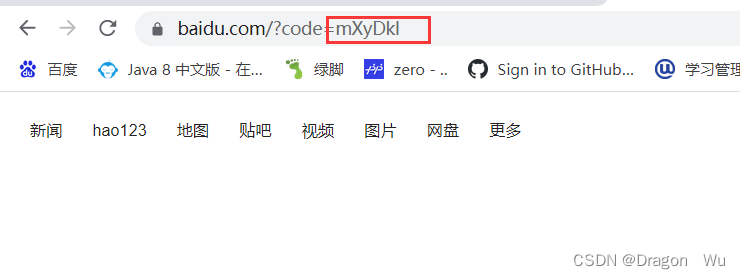
(2)获取令牌

用户名、密码就是授权服务器里的用户名密码

填写对应参数:
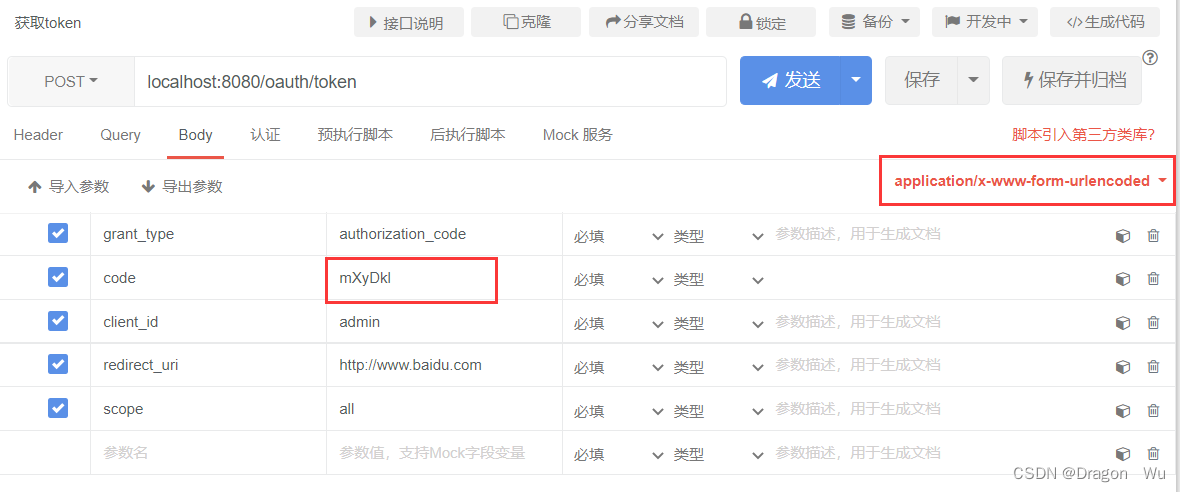
发生请求:
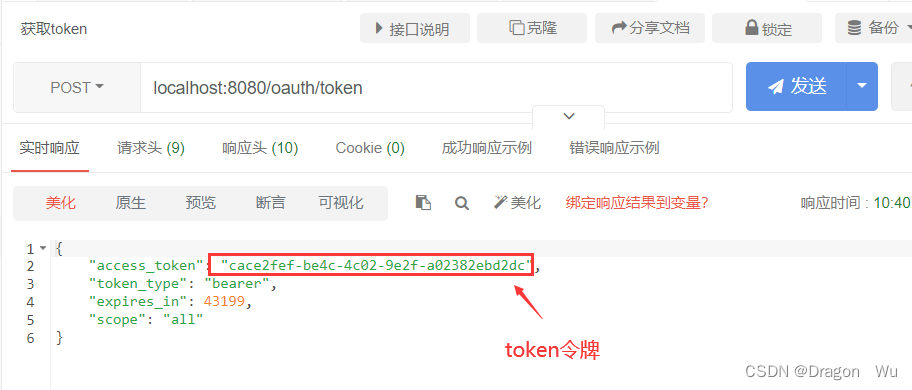
(3)获取我们自己写的接口的数据:

选择Bearer auth认证填入对应token
获取到对应用户信息:

** 加密模式获取资源的步骤**
(1)通过授权服务获取token
认证配置与授权时一样
传入参数有所不同:

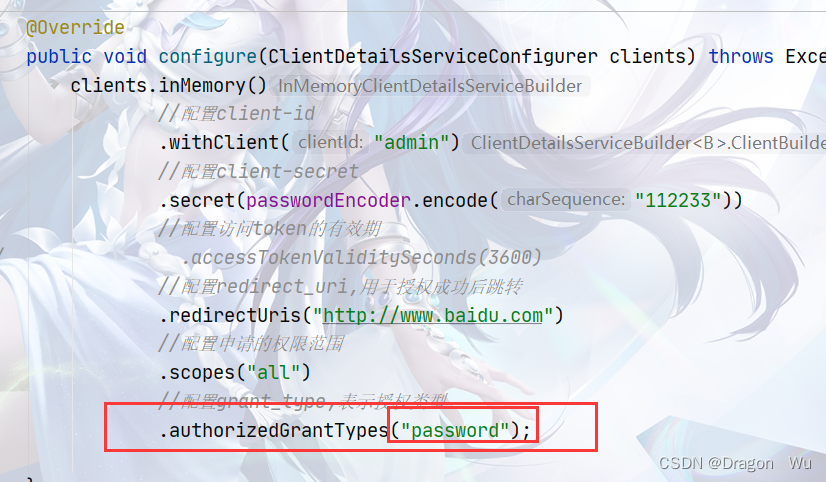
通过用户名密码获取到对应token
 ** (2)获取对应接口资源,与之前授权模式获取接口之源一样**
** (2)获取对应接口资源,与之前授权模式获取接口之源一样**
6、存在到Redis里,后续推荐使用JWT
以上授权的数据是放到内存中的实际开发过程中应将其放到redis里
(1)添加redis依赖与配置
<dependency>
<groupId>org.springframework.boot</groupId>
<artifactId>spring-boot-starter-data-redis</artifactId>
</dependency>
spring:
redis:
database: 1
host: my-server
port: 6380
password:
(2)配置类
@Configuration
public class RedisConfig {
@Autowired
private RedisConnectionFactory redisConnectionFactory;
@Bean
public TokenStore redisTokenStore(){
return new RedisTokenStore(redisConnectionFactory);
}
}
@Configuration
@EnableAuthorizationServer //开启授权服务器
public class AuthorizationServerConfig extends AuthorizationServerConfigurerAdapter {
@Autowired
private PasswordEncoder passwordEncoder;
@Autowired
private AuthenticationManager authenticationManager;
@Autowired
private UserDetailsServiceImpl userDetailsService;
@Autowired
@Qualifier("redisTokenStore")
private TokenStore tokenStore;
//使用密码模式配置所需配置
@Override
public void configure(AuthorizationServerEndpointsConfigurer endpoints) throws Exception {
endpoints.authenticationManager(authenticationManager)
.userDetailsService(userDetailsService)
.tokenStore(tokenStore);
}
@Override
public void configure(ClientDetailsServiceConfigurer clients) throws Exception {
clients.inMemory()
//配置client-id
.withClient("admin")
//配置client-secret
.secret(passwordEncoder.encode("112233"))
//配置访问token的有效期
// .accessTokenValiditySeconds(3600)
//配置redirect_uri,用于授权成功后跳转
.redirectUris("http://www.baidu.com")
//配置申请的权限范围
.scopes("all")
//配置grant_type,表示授权类型
.authorizedGrantTypes("password");
}
}

放到获取token的接口后可以看到:数据已存在redis中去了

三、JWT认证机制

1、JWT的组成
JWT是由
.
分割的如下三部分组成:
头部(Header)
Header 一般由两个部分组成:
- alg
- typ
alg
是是所使用的hash算法,如:HMAC SHA256或RSA,
typ
是Token的类型,在这里就是:JWT。
{
"alg": "HS256",
"typ": "JWT"
}
然后使用Base64Url编码成第一部分:
eyJhbGciOiJIUzI1NiIsInR5cCI6IkpXVCJ9.<second part>.<third part>
载荷(Payload)
这一部分是JWT主要的信息存储部分,其中包含了许多种的声明(claims)。
Claims的实体一般包含用户和一些元数据,这些claims分成三种类型:
- reserved claims:预定义的 一些声明,并不是强制的但是推荐,它们包括 iss (issuer), exp (expiration time), sub (subject),aud(audience) 等(这里都使用三个字母的原因是保证 JWT 的紧凑)。
- public claims: 公有声明,这个部分可以随便定义,但是要注意和 IANA JSON Web Token 冲突。
- private claims: 私有声明,这个部分是共享被认定信息中自定义部分。
一个简单的Pyload可以是这样子的:
{
"sub": "1234567890",
"name": "John Doe",
"admin": true
}
这部分同样使用Base64Url编码成第二部分:
eyJhbGciOiJIUzI1NiIsInR5cCI6IkpXVCJ9.eyJzdWIiOiIxMjM0NTY3ODkwIiwibmFtZSI6IkpvaG4gRG9lIiwiYWRtaW4iOnRydWV9.<third part>
签名(Signature)
Signature是用来验证发送者的JWT的同时也能确保在期间不被篡改。
在创建该部分时候你应该已经有了编码后的Header和Payload,然后使用保存在服务端的秘钥对其签名,一个完整的JWT如下:
eyJhbGciOiJIUzI1NiIsInR5cCI6IkpXVCJ9.eyJzdWIiOiIxMjM0NTY3ODkwIiwibmFtZSI6IkpvaG4gRG9lIiwiYWRtaW4iOnRydWV9.TJVA95OrM7E2cBab30RMHrHDcEfxjoYZgeFONFh7HgQ
因此使用JWT具有如下好处:
- 通用:因为json的通用性,所以JWT是可以进行跨语言支持的,像JAVA,JavaScript,NodeJS,PHP等很多语言都可以使用。
- 紧凑:JWT的构成非常简单,字节占用很小,可以通过 GET、POST 等放在 HTTP 的 header 中,非常便于传输。
- 扩展:JWT是自我包涵的,包含了必要的所有信息,不需要在服务端保存会话信息, 非常易于应用的扩展。
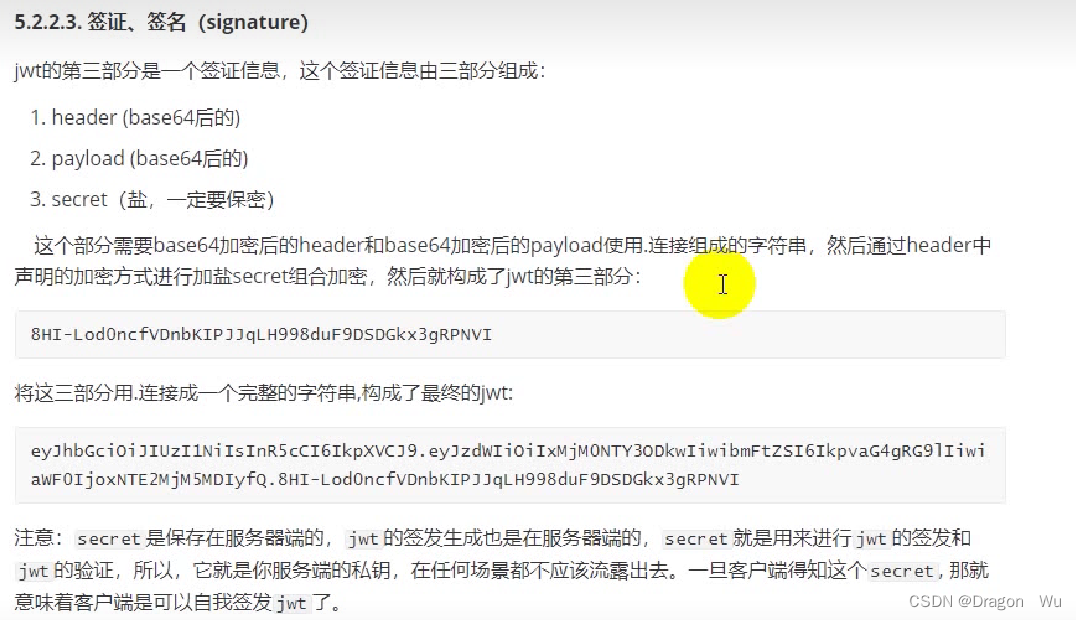
2、依赖引入
<dependency>
<groupId>io.jsonwebtoken</groupId>
<artifactId>jjwt</artifactId>
<version>0.9.1</version>
</dependency>
3、生成JWT的测试
private void createToken() {
//当前系统时间
long now = System.currentTimeMillis();
//过期时间,1分钟
long exp = now + 60 * 1000;
//创建JwtBuilder对象
JwtBuilder jwtBuilder = Jwts.builder()
//声明的标识{“jti”:"8888"}
.setId("8888")
//主体,用户{“sub”:"Rose"}
.setSubject("Rose")
//创建日期{“ita”:“xxxxxx”}
.setIssuedAt(new Date())
.signWith(SignatureAlgorithm.HS256, "xxxxxx")
//设置过期时间
.setExpiration(new Date(exp));
//获取jwt的token
String token = jwtBuilder.compact();
System.out.println(token);
System.out.println("=======================================");
String[] split = token.split("\\.");
System.out.println(Base64Codec.BASE64.decodeToString(split[0]));
System.out.println(Base64Codec.BASE64.decodeToString(split[1]));
//无法解密
System.out.println(Base64Codec.BASE64.decodeToString(split[2]));
}
打印如下:密码盐一般为服务器的私钥

4、解析JWT
private void parseJWT() {
String jwt = "eyJhbGciOiJIUzI1NiJ9.eyJqdGkiOiI4ODg4Iiwic3ViIjoiUm9zZSIsImlhdCI6MTY2NTAzNzc0MSwiZXhwIjoxNjY1MDM3ODAxfQ.jGZrGW0sYyfuatsi1xtYXI8pPflRZR4DY3BbwmSKN0M";
//解析token获取负载中声明的对象
Claims claims = Jwts.parser()
.setSigningKey("xxxxxx")
.parseClaimsJws(jwt)
.getBody();
System.out.println("id:" + claims.getId());
System.out.println("subject:" + claims.getSubject());
System.out.println("issuedAt:" + claims.getIssuedAt());
SimpleDateFormat simpleDateFormat = new SimpleDateFormat("yyyy-MM-dd HH:mm:ss");
System.out.println("签发时间:" + simpleDateFormat.format(claims.getIssuedAt()));
System.out.println("过期时间:" + simpleDateFormat.format(claims.getExpiration()));
System.out.println("当前时间:" + simpleDateFormat.format(new Date()));
}

5、自定义声明
//自定义声明
private void createJWTByClaims() {
//当前系统时间
long now = System.currentTimeMillis();
//过期时间,1分钟
long exp = now + 60 * 1000;
//创建JwtBuilder对象
JwtBuilder jwtBuilder = Jwts.builder()
//声明的标识{“jti”:"8888"}
.setId("8888")
//主体,用户{“sub”:"Rose"}
.setSubject("Rose")
//创建日期{“ita”:“xxxxxx”}
.setIssuedAt(new Date())
.signWith(SignatureAlgorithm.HS256, "xxxxxx")
//设置过期时间
.setExpiration(new Date(exp))
//自定义声明的使用
.claim("roles", "admin")
.claim("logo", "xxx.jpg");
//直接传入Map
// .setClaims(map)
//获取jwt的token
String token = jwtBuilder.compact();
System.out.println(token);
}
解析:
private void parseJWTClaims() {
String jwt = "eyJhbGciOiJIUzI1NiJ9.eyJqdGkiOiI4ODg4Iiwic3ViIjoiUm9zZSIsImlhdCI6MTY2NTAzODQwMiwiZXhwIjoxNjY1MDM4NDYxLCJyb2xlcyI6ImFkbWluIiwibG9nbyI6Inh4eC5qcGcifQ.fzyWQ_HG725kDoZ0zljHkIiIrO1mhl_u77r81ZeT1FA";
//解析token获取负载中声明的对象
Claims claims = Jwts.parser()
.setSigningKey("xxxxxx")
.parseClaimsJws(jwt)
.getBody();
System.out.println("id:" + claims.getId());
System.out.println("subject:" + claims.getSubject());
System.out.println("issuedAt:" + claims.getIssuedAt());
System.out.println("roles:" + claims.get("roles"));
System.out.println("logo:" + claims.get("logo"));
}
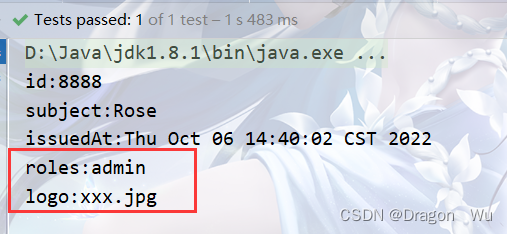
四、SpringSecurityOauth2整合JWT
1、添加配置类
Jwt的配置类
@Configuration
public class JwtTokenStoreConfig {
@Bean
public TokenStore jwtTokenStore() {
return new JwtTokenStore(jwtAccessTokenConverter());
}
@Bean
public JwtAccessTokenConverter jwtAccessTokenConverter() {
JwtAccessTokenConverter accessTokenConverter = new JwtAccessTokenConverter();
//配置jwt使用的密钥
accessTokenConverter.setSigningKey("test_key");
return accessTokenConverter;
}
@Bean
public JwtTokenEnhancer jwtTokenEnhancer(){
return new JwtTokenEnhancer();
}
}
Jwt内容增强器的配置类:
public class JwtTokenEnhancer implements TokenEnhancer {
@Override
public OAuth2AccessToken enhance(OAuth2AccessToken oAuth2AccessToken, OAuth2Authentication oAuth2Authentication) {
Map<String, Object> info = new HashMap<>();
//放入jwt里的内容
info.put("enhance", "enhance info");
((DefaultOAuth2AccessToken) oAuth2AccessToken).setAdditionalInformation(info);
return oAuth2AccessToken;
}
}
授权服务器配置类:
@Configuration
@EnableAuthorizationServer //开启授权服务器
public class AuthorizationServerConfig extends AuthorizationServerConfigurerAdapter {
@Autowired
private PasswordEncoder passwordEncoder;
@Autowired
private AuthenticationManager authenticationManager;
@Autowired
private UserDetailsServiceImpl userDetailsService;
@Autowired
@Qualifier("jwtTokenStore")
private TokenStore tokenStore;
@Autowired
private JwtAccessTokenConverter jwtAccessTokenConverter;
@Autowired
private JwtTokenEnhancer jwtTokenEnhancer;
//使用密码模式配置所需配置
@Override
public void configure(AuthorizationServerEndpointsConfigurer endpoints) throws Exception {
//配置JWT内容增强器
TokenEnhancerChain enhancerChain = new TokenEnhancerChain();
List<TokenEnhancer> delegates = new ArrayList<>();
delegates.add(jwtTokenEnhancer);
delegates.add(jwtAccessTokenConverter);
enhancerChain.setTokenEnhancers(delegates);
endpoints.authenticationManager(authenticationManager)
.userDetailsService(userDetailsService)
//配置存储令牌策略
.tokenStore(tokenStore)
.accessTokenConverter(jwtAccessTokenConverter)
//配置内容增强器
.tokenEnhancer(enhancerChain);
}
@Override
public void configure(ClientDetailsServiceConfigurer clients) throws Exception {
clients.inMemory()
//配置client-id
.withClient("admin")
//配置client-secret
.secret(passwordEncoder.encode("112233"))
//配置访问token的有效期
.accessTokenValiditySeconds(3600)
//配置刷新令牌的有效期
.refreshTokenValiditySeconds(864000)
//配置redirect_uri,用于授权成功后跳转
.redirectUris("http://localhost:8081/login")
//配置申请的权限范围
.scopes("all")
//配置grant_type,表示授权类型, 刷新令牌
.authorizedGrantTypes("password","refresh_token");
}
}

重启项目:
使用正确密码模式的访问接口进行测试:可以看到目前的token已经是JWT的token了
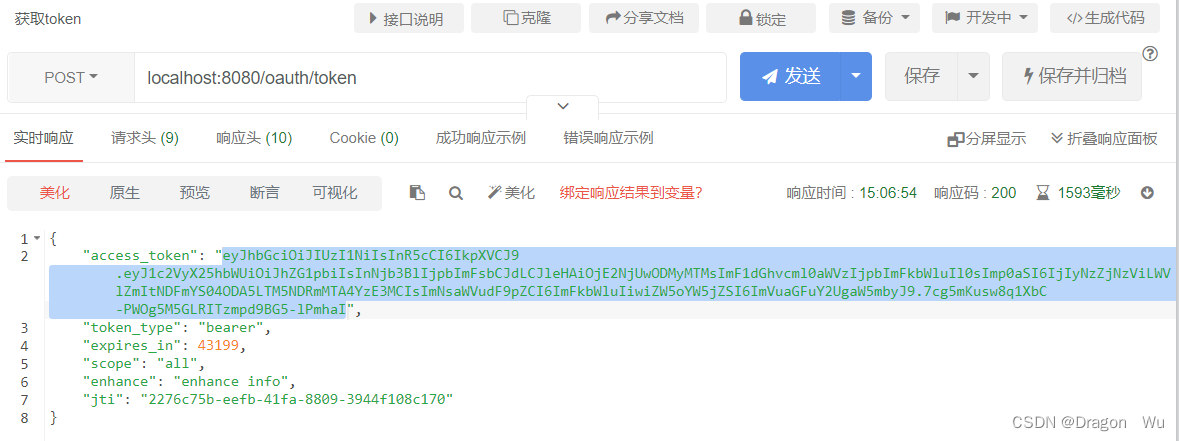
将此token放到官网解析可以看到对应增加的信息:

2、Jwt的解析
这里需要引入之前集成JWT的依赖
添加访问接口进行测试
@GetMapping("/getCurrentUser")
public Object getCurrentUser(Authentication authentication, HttpServletRequest request) {
String head = request.getHeader("Authorization");
String token = head.substring(head.indexOf("bearer") + 7);
return Jwts.parser()
.setSigningKey("test_key".getBytes(StandardCharsets.UTF_8))
.parseClaimsJws(token)
.getBody();
}
访问该接口,仅需传入请求头Authorization和对应的bearer+JWT即可:

解析完毕:

3、刷新token
授权服务器配置如下:

再次测试:可以看到刷新时的token


五、SpringSecurityOauth2实现单点登录
我以之前的授权服务器作为授权服务器,现在在创建一个服务器作为单点请求登录的服务器客户端。依赖与授权服务器相同。
1、添加对应配置
server:
port: 8081
servlet:
session:
# 防止Cookie冲突,冲突会导致登录验证不通过
cookie:
name: OAUTH2-CLIENT-SESSIONID01
# 授权服务器地址
oauth2-server-url: http://localhost:8080
# 与授权服务器对应的配置
security:
oauth2:
client:
client-id: admin
client-secret: 112233
user-authorization-uri: ${oauth2-server-url}/oauth/authorize
access-token-uri: ${oauth2-server-url}/oauth/token
resource:
jwt:
key-uri: ${oauth2-server-url}/oauth/token_key

使用单点登录时授权服务器的授权配置类:
@Configuration
@EnableAuthorizationServer //开启授权服务器
public class AuthorizationServerConfig extends AuthorizationServerConfigurerAdapter {
@Autowired
private PasswordEncoder passwordEncoder;
@Autowired
private AuthenticationManager authenticationManager;
@Autowired
private UserDetailsServiceImpl userDetailsService;
@Autowired
@Qualifier("jwtTokenStore")
private TokenStore tokenStore;
@Autowired
private JwtAccessTokenConverter jwtAccessTokenConverter;
@Autowired
private JwtTokenEnhancer jwtTokenEnhancer;
//使用密码模式配置所需配置
@Override
public void configure(AuthorizationServerEndpointsConfigurer endpoints) throws Exception {
//配置JWT内容增强器
TokenEnhancerChain enhancerChain = new TokenEnhancerChain();
List<TokenEnhancer> delegates = new ArrayList<>();
delegates.add(jwtTokenEnhancer);
delegates.add(jwtAccessTokenConverter);
enhancerChain.setTokenEnhancers(delegates);
endpoints.authenticationManager(authenticationManager)
.userDetailsService(userDetailsService)
//配置存储令牌策略
.tokenStore(tokenStore)
.accessTokenConverter(jwtAccessTokenConverter)
//配置内容增强器
.tokenEnhancer(enhancerChain);
}
@Override
public void configure(ClientDetailsServiceConfigurer clients) throws Exception {
clients.inMemory()
//配置client-id
.withClient("admin")
//配置client-secret
.secret(passwordEncoder.encode("112233"))
//配置访问token的有效期
.accessTokenValiditySeconds(3600)
//配置刷新令牌的有效期
.refreshTokenValiditySeconds(864000)
//配置redirect_uri,用于授权成功后跳转
.redirectUris("http://localhost:8081/login")
//自动授权配置
.autoApprove(true)
//配置申请的权限范围
.scopes("all")
//配置grant_type,表示授权类型, 刷新令牌
.authorizedGrantTypes("password", "refresh_token", "authorization_code");
}
@Override
public void configure(AuthorizationServerSecurityConfigurer security) throws Exception {
//获取密钥需要身份认证,使用单点登录时必须配置
security.tokenKeyAccess("isAuthenticated()");
}
}
访问客户端的接口:
http://localhost:8081/user/getCurrentUser
此时,会跳转到授权服务器的登录页面:

登录成功访问到对应接口资源:

总结到此。
版权归原作者 Dragon Wu 所有, 如有侵权,请联系我们删除。